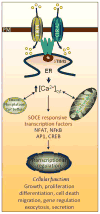The TR (i)P to Ca²⁺ signaling just got STIMy: an update on STIM1 activated TRPC channels
- PMID: 22201775
- PMCID: PMC3293191
- DOI: 10.2741/3958
The TR (i)P to Ca²⁺ signaling just got STIMy: an update on STIM1 activated TRPC channels
Abstract
Calcium is a ubiquitous signaling molecule, indispensable for cellular metabolism of organisms from unicellular life forms to higher eukaryotes. The biological function of most eukaryotic cells is uniquely regulated by changes in cytosolic calcium, which is largely achieved by the universal phenomenon of store-operated calcium entry (SOCE). The canonical TRPs and Orai channels have been described as the molecular components of the store-operated calcium channels (SOCC). Importantly, the ER calcium-sensor STIM1 has been shown to initiate SOCE via gating of SOCC. Since the discovery of STIM1, as the critical regulator of SOCE, there has been a flurry of observations suggesting its obligatory role in regulating TRPC and Orai channel function. Considerable effort has been made to identify the molecular details as how STIM1 activates SOCC. In this context, findings as of yet has substantially enriched our understanding on, the modus operandi of SOCE, the distinct cellular locales that organize STIM1-SOCC complexes, and the physiological outcomes entailing STIM1-activated SOCE. In this review we discuss TRPC channels and provide an update on their functional regulation by STIM1.
Figures




Similar articles
-
Store-operated calcium entry: Pivotal roles in renal physiology and pathophysiology.Exp Biol Med (Maywood). 2021 Feb;246(3):305-316. doi: 10.1177/1535370220975207. Epub 2020 Nov 29. Exp Biol Med (Maywood). 2021. PMID: 33249888 Free PMC article. Review.
-
Lipid rafts determine clustering of STIM1 in endoplasmic reticulum-plasma membrane junctions and regulation of store-operated Ca2+ entry (SOCE).J Biol Chem. 2008 Jun 20;283(25):17333-40. doi: 10.1074/jbc.M800107200. Epub 2008 Apr 22. J Biol Chem. 2008. PMID: 18430726 Free PMC article.
-
Contribution and regulation of TRPC channels in store-operated Ca2+ entry.Curr Top Membr. 2013;71:149-79. doi: 10.1016/B978-0-12-407870-3.00007-X. Curr Top Membr. 2013. PMID: 23890115 Free PMC article. Review.
-
Functional interactions among Orai1, TRPCs, and STIM1 suggest a STIM-regulated heteromeric Orai/TRPC model for SOCE/Icrac channels.Proc Natl Acad Sci U S A. 2008 Feb 26;105(8):2895-900. doi: 10.1073/pnas.0712288105. Epub 2008 Feb 19. Proc Natl Acad Sci U S A. 2008. PMID: 18287061 Free PMC article.
-
STIM-TRP Pathways and Microdomain Organization: Ca2+ Influx Channels: The Orai-STIM1-TRPC Complexes.Adv Exp Med Biol. 2017;993:139-157. doi: 10.1007/978-3-319-57732-6_8. Adv Exp Med Biol. 2017. PMID: 28900913 Review.
Cited by
-
Increasing cytosolic Ca2+ levels restore cell proliferation and stem cell potency in aged MSCs.Stem Cell Res. 2021 Oct;56:102560. doi: 10.1016/j.scr.2021.102560. Epub 2021 Oct 3. Stem Cell Res. 2021. PMID: 34624617 Free PMC article.
-
Impairment of TRPC1-STIM1 channel assembly and AQP5 translocation compromise agonist-stimulated fluid secretion in mice lacking caveolin1.J Cell Sci. 2013 Jan 15;126(Pt 2):667-75. doi: 10.1242/jcs.118943. Epub 2012 Nov 30. J Cell Sci. 2013. PMID: 23203809 Free PMC article.
-
TRPC1-mediated Ca²⁺ entry is essential for the regulation of hypoxia and nutrient depletion-dependent autophagy.Cell Death Dis. 2015 Mar 5;6(3):e1674. doi: 10.1038/cddis.2015.7. Cell Death Dis. 2015. PMID: 25741599 Free PMC article.
-
TRPC1 intensifies house dust mite-induced airway remodeling by facilitating epithelial-to-mesenchymal transition and STAT3/NF-κB signaling.FASEB J. 2019 Jan;33(1):1074-1085. doi: 10.1096/fj.201801085R. Epub 2018 Aug 1. FASEB J. 2019. PMID: 30067380 Free PMC article.
-
Endothelial control of vasodilation: integration of myoendothelial microdomain signalling and modulation by epoxyeicosatrienoic acids.Pflugers Arch. 2014 Mar;466(3):389-405. doi: 10.1007/s00424-013-1303-3. Epub 2013 Jun 8. Pflugers Arch. 2014. PMID: 23748495 Free PMC article. Review.
References
-
- Berridge MJ. Calcium microdomains: organization and function. Cell Calcium. 2006;40(5–6):405–12. - PubMed
-
- Ambudkar IS. Cellular domains that contribute to Ca2+ entry events. Sci STKE. 2004;2004(243):pe32. - PubMed
-
- Berridge MJ, Bootman MD, Roderick HL. Calcium signalling: dynamics, homeostasis and remodelling. Nat Rev Mol Cell Biol. 2003;4(7):517–29. - PubMed
Publication types
MeSH terms
Substances
Grants and funding
LinkOut - more resources
Full Text Sources
Miscellaneous

